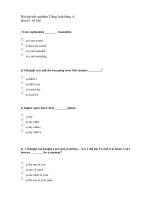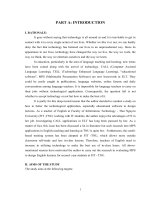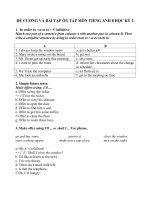Thiết kế bài tập TNKQ Tiếng Anh
Bạn đang xem bản rút gọn của tài liệu. Xem và tải ngay bản đầy đủ của tài liệu tại đây (274.17 KB, 40 trang )
October 18, 2013 Designing objective tests 1
DESIGNING
ENGLISH
OBJECTIVE TESTS
AT UPPER-
SECONDARY
SCHOOLS
October 18, 2013 Designing objective tests 2
TYPES OF
OBJECTIVE TESTS
1. Matching Items
E.g. Match the jobs with their definitions
a. farmer 1. This person looks after
young children.
b. dentist 2. This person has pigs, cows
and sheep.
c. babysitter 3. This person keeps our teeth
white, clean, and healthy.
Answer: a-2; b-3; c-1
October 18, 2013 Designing objective tests 3
TYPES OF
OBJECTIVE TESTS
2. Supply Items
E.g. The relative pronoun WHO is used to
replace a _______.
Answer: person
3. Short answer
E.g. What is the superlative form of GOOD?
Answer: the best
October 18, 2013 Designing objective tests 4
TYPES OF
OBJECTIVE TESTS
4. True/ False Questions
E.g. Decide if the following statement is
true (T) or false (F)
The present simple can be used to
describe a habitual action.
Answer: T
October 18, 2013 Designing objective tests 5
TYPES OF
OBJECTIVE TESTS
5. Multiple Choice Questions (MCQs)
E.g. Choose the best answer a, b, c, or d to fill in
the blank.
The man _____ you met at the party is Mary’s
boyfriend.
A. which
B. whose
C. whom
D. who
Answer: c
October 18, 2013 Designing objective tests 6
QUALITIES OF GOOD
MCQs
•
Validity: Items measure only what they
are supposed to measure.
•
Fairness: Items do not unfairly
advantage or disadvantage certain
groups or people
•
Sensitivity: Items avoid offensive or
upsetting language, situations or actions
•
Difficulty: Items are written at
appropriate levels of difficulty
October 18, 2013 Designing objective tests 7
TYPES OF MCQs
1. Select correct answer
2. Select incorrect answer
3. Fill in the blank
4. Match 1 or 2
5. Mismatched
6. Sequence of events
October 18, 2013 Designing objective tests 8
1. Select correct
answer
Choose the correct passive transformation of the
following sentence.
The others told the new students where to sit.
A. The new students were told where to sit.
B. The others were told where to sit by the
students.
C. Where to sit was told to the new students
by the others.
D. The new students were told where to sit
by the others.
Answer: D
October 18, 2013 Designing objective tests 9
2. Select incorrect
answer
All of the following words can be followed
by an infinitive EXCEPT for:
A. Want
B. Remember
C. Enjoy
D. Hope
Answer: C
October 18, 2013 Designing objective tests 10
3. Fill in the blank
Choose ONE word to fill in the blank.
Your birthplace is where you were…….
A. living
B. born
C. visiting
D. working
Answer: B
October 18, 2013 Designing objective tests 11
4. Match 1 or 2
Choose the correct pair of words to fill in
the blank.
_____ student asked a question; _____
answer it.
A. One/ the
B. The/ one
C. One/ another
D. The/ another
Answer: A
October 18, 2013 Designing objective tests 12
5. Mismatched
Which adjective is mismatched with its
antonym?
A. consistent; unconsistent
B. like; unlike
C. sympathetic; unsympathetic
D. kind; unkind
Answer: a
October 18, 2013 Designing objective tests 13
6. Sequence of
events
Having finished the work, he turned off the computer
and left the office after checking all the windows to
make sure they were locked.
The right sequence of action is:
A. Finished the work; turned off the computer; left the
office; checked the window
B. Finished the work; turned off the computer; checked the
windows; left the office
C. Finished the work; left the office; turned off the
computer; checked the window
D. Turned off the computer; checked the window; finished
the work, left the office.
Answer: b
October 18, 2013 Designing objective tests 14
COMMON ITEM
PROBLEMS
1. Cueing
2. Impurity
3. Apples and oranges
4. Unparallel options
5. Gender representation
October 18, 2013 Designing objective tests 15
COMMON ITEM
PROBLEMS
6. Stereotypes
7. Double keys
8. No key
9. Outside or Background
Knowledge
10. Trickiness
11. Insensitivity
October 18, 2013 Designing objective tests 16
1. CUEING
Answer found within stem
When you write “for deposit only” on a
check, you are probably going to …
a. cash a check
b. deposit money
c. transfer funds
d. open an accounts









